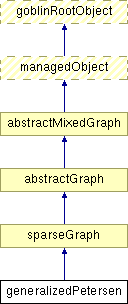
#include <sparseGraph.h>
Inheritance diagram for generalizedPetersen:

Public Member Functions | |
| generalizedPetersen (TNode perimeter, TNode skew, goblinController &_CT=goblinDefaultContext) throw (ERRejected) | |
|
||||||||||||||||
|
Generate a Petersen like graph.
0, 1, .., perimeter-1 of exterior nodes forms a cycle. Exterior and interior nodes are joined by the edges (i, perimeter+i) with i in the interval [0, .., perimeter). Interior nodes are joined by the edges (perimeter+i, perimeter+(i+skew)perimeter).
In the regular setting, perimeter and skew are relatively prime, and the subgraph induced by the second node set
Up to the implicit arc orientations of the interior cycle,
The original Petersen graph is given by
|